An Unmet Clinical Need
Head drop is a devastating condition in patients with a neurological disorder, such as amyotrophic lateral sclerosis (ALS). In ALS, the patients progressively lose muscle strengths and currently there is no cure. Due to weakness, a patient may have difficulty to hold the head upright or move it around. Head drop also blocks the airway of a patient, making it challenging to breathe, swallow, and speak.
Current care is limited. Static neck collars are often prescribed by physicians. Wheelchair users may also be able to recline the chair to rest the head or add a strap to fix the head upright. However, these solutions are not adopted by patients because they do not meet their needs, which is to restore the posture and movement of the head-neck. Fixing the head at a single configuration for too long is uncomfortable and also prevents a patient from interacting with others, such as making simple eye contacts in a conversation.
The Design Process
Movement Characterization
A motion capture system was used to characterize normal head-neck motion in human. The six degrees-of-freedom motion of the head relative to shoulders was of particular interest. Infrared markers were placed on both the face and the trunk of human subjects. The data shows that the head-neck motion possesses large rotations but small translations.
Mathematical Model
A novel 3-Revolute-Revolute-Spherical (3-RRS) parallel mechanism was used to capture the motion of the head-neck. The end-effector connects to the inertial base through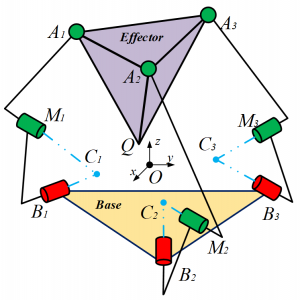 three mechanical chains in parallel. The joints in each kinematic chain are revolute, revolute, and spherical joints. In each chain, the two revolute axes are required to intersect at a point. Overall, there are three such fixed points from three chains. As a result, the end-effector has three degrees-of-freedom, with coupled rotations and translations.
three mechanical chains in parallel. The joints in each kinematic chain are revolute, revolute, and spherical joints. In each chain, the two revolute axes are required to intersect at a point. Overall, there are three such fixed points from three chains. As a result, the end-effector has three degrees-of-freedom, with coupled rotations and translations.
Since this robot uses a parallel architecture, its kinematics modelling is a bit more complicate compared to a serial-chain robot. However, this design choice allows all the actuators to be placed on the inertial base, making the robot lightweight during dynamic motion.
Eventually, the end-effector will be snuggly connected to the head and the inertial base will be fixed onto the shoulders. This mechanism is easy to assemble and its parameters can be optimized to meet the movement data of human subjects.
Physical Model
A hierarchical random search was used to optimize the design parameters, such as the link lengths, the placements of the intersecting points from the chains, etc. The optimization had two main objectives – to maximize the range of rotation and to minimize the translational error compared to human data.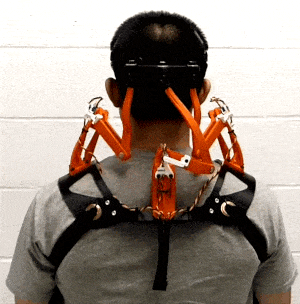
The search space of parameters were selected so that the mechanical structure would be at the back of the user. As a result, the space in the front is open and the machine would not block the airway or the sight of view of the user. With this choice, the ranges of motion for head extension was also limited to protect the user from hyper-extending the neck. Overall, the robot allows about 70% ranges of rotations of the head-neck.
The development of this neck robot has gone through several iterations. In its current form, three Dynamixel servomotors are mounted at the base joints of the robot. With these motors, the robotic brace is highly back-drivable. They also provide position measurements through optical encoders, and current measurements through current sensors.
Applications
Though initially designed for head drop patients, the robot has been used in many other applications. Below are several examples of these applications:
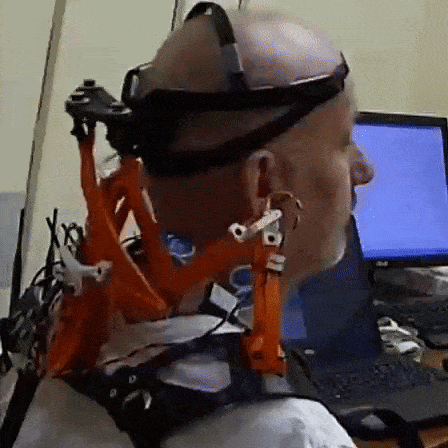
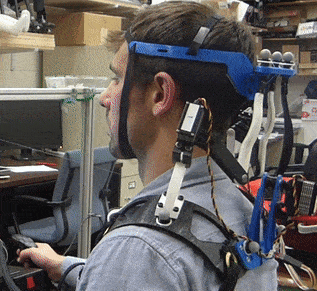
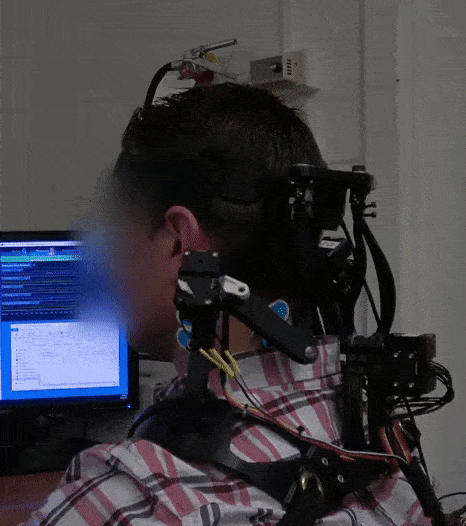
What’s Next?
We have demonstrated the feasibility of using this robotic device for different applications. In the future, this robot could be used to investigate new therapeutic intervention or to study the neuromuscular system.
However, challenges still remain from the design and control point of view. One of the challenges to give this device to an ALS patient with head drop to use from home is that the current user interface requires a patient to have control in their upper limbs to use a joystick or keyboard. Such a control may not be available for an ALS patient. Hence, I am searching for other methods to inquire the intent of a user without hand-held control inputs.
One possibility is to track the eye movements. One observation is that the head-neck movement during daily tasks is often guided by the eye movements, e.g., making eye contacts during a conversation. We have recently been able to integrate a commercial eye-tracker with our brace and came up with simple heuristic to commend the head-neck movements with the eyes. However, this rule-based controller may overly simplify the coordinated eye-head movements. Perhaps, data-driven approaches may help address this limitation in the future designs.
